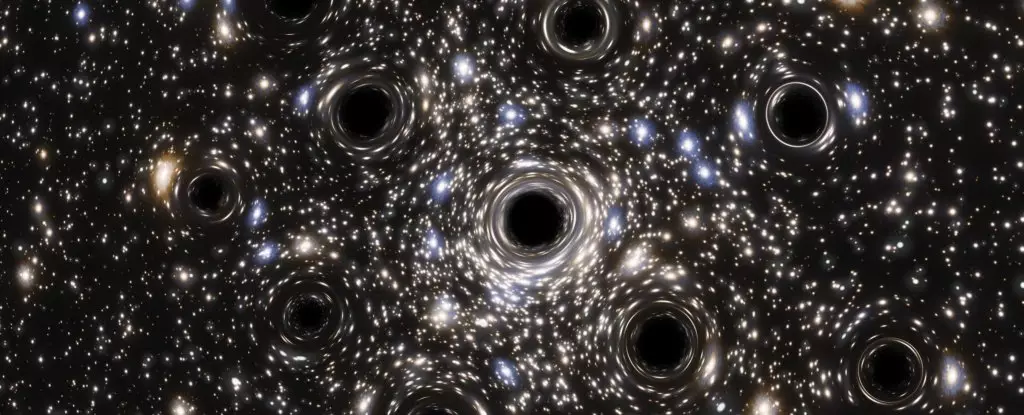Deep within our galaxy, a captivating phenomenon is unfolding, one that bridges the worlds of stellar evolution, dark matter studies, and the enigma of black holes. At the heart of this exploration lies Palomar 5, a globular cluster that has recently garnered interest for harboring a surprisingly high population of stellar-mass black holes. Spanning approximately 30,000 light-years and positioned about 80,000 light-years from Earth, Palomar 5 presents an intriguing case study for astronomers seeking to untangle the formation and evolution of both stellar clusters and tidal streams.
Globular clusters like Palomar 5 are often dubbed “fossils” of the early Universe, embodying not only ancient stars but also the physical processes that govern their formation. Typically comprising between 100,000 and 1 million stars, these clusters are densely packed and spherical, representing a snapshot of stellar history. However, they are not simply cosmic relics; they serve as critical laboratories for investigating the broader evolution of galaxies.
The discovery of tidal streams—long, winding trails of stars—has sparked excitement among astronomers. These streams, which can stretch across the sky, provide tantalizing clues about the dynamical history of galaxies. Although identifying these streams has been arduous, advancements from the Gaia space observatory have enabled researchers to map the Milky Way with unprecedented clarity. This new capability has led to a burgeoning interest in understanding how these streams form, with some hypotheses pointing to the disruption of star clusters.
Yet, the conundrum remains: researchers have struggled to pinpoint the mechanisms behind the formation of these streams, especially when no associated star cluster can be directly identified. In this context, Palomar 5 emerges as a critical focal point. According to astrophysicist Mark Gieles, the uniqueness of Palomar 5 lies in its robust tidal stream and associated cluster, which makes it a “Rosetta Stone” for understanding how stellar streams develop. Gieles and his team took on the challenge of studying this peculiar cluster to get closer to understanding these astronomical phenomena.
Employing sophisticated N-body simulations, Gieles’s team endeavored to unravel the motions and evolutionary trajectories of Palomar 5’s stars. Each simulation aimed to replicate the current configuration of the cluster, allowing scientists to analyze how interactions among stars and potential black holes might shape their fate. In light of recent findings suggesting that substantial populations of black holes reside in globular clusters’ cores, the researchers incorporated these entities into their models.
The results were revelatory. It became clear that the presence of a significant number of black holes—estimates suggest three times more than previously thought—could account for the dynamic behavior of stars escaping the cluster. The simulations indicated that about 20% of Palomar 5’s mass is constituted of black holes, each possessing approximately twenty times the mass of our Sun, formed from the remnants of massive stars that exploded in supernovae long ago.
What does the trajectory of Palomar 5 mean for the understanding of globular clusters as a whole? The simulations suggest that Palomar 5 is not an anomaly in the cosmos but rather a glimpse into the future for other globular clusters. Over the next billion years, Palomar 5 is predicted to disintegrate entirely, leaving behind a collection of black holes orbiting the center of the Milky Way. This projection implies that many other globular clusters may share a similar fate, with their stars eventually joining tidal streams as they dissolve.
This research bears significant implications for the pursuit of understanding black hole mergers. It has long been hypothesized that many binary black hole mergers occur within star clusters, where gravitational interactions play a crucial role. Scientists now have a clearer understanding of how many black holes could be present in these clusters, which remains a profound question in astrophysics due to the inherent difficulties in detecting black holes directly.
The journey to comprehend the mysteries of Palomar 5 and its implications spans far beyond our immediate neighborhood in the Milky Way. This cluster, with its rich tapestry of stars and intriguing black hole population, symbolizes a convergence of phenomena that challenges our understanding of stellar and galactic evolution. As astronomers continue to wield advanced tools and simulations, the fate of Palomar 5 will likely serve as a beacon, guiding further research into the interplay between stellar clusters, black holes, and the fundamental architecture of the universe itself.

